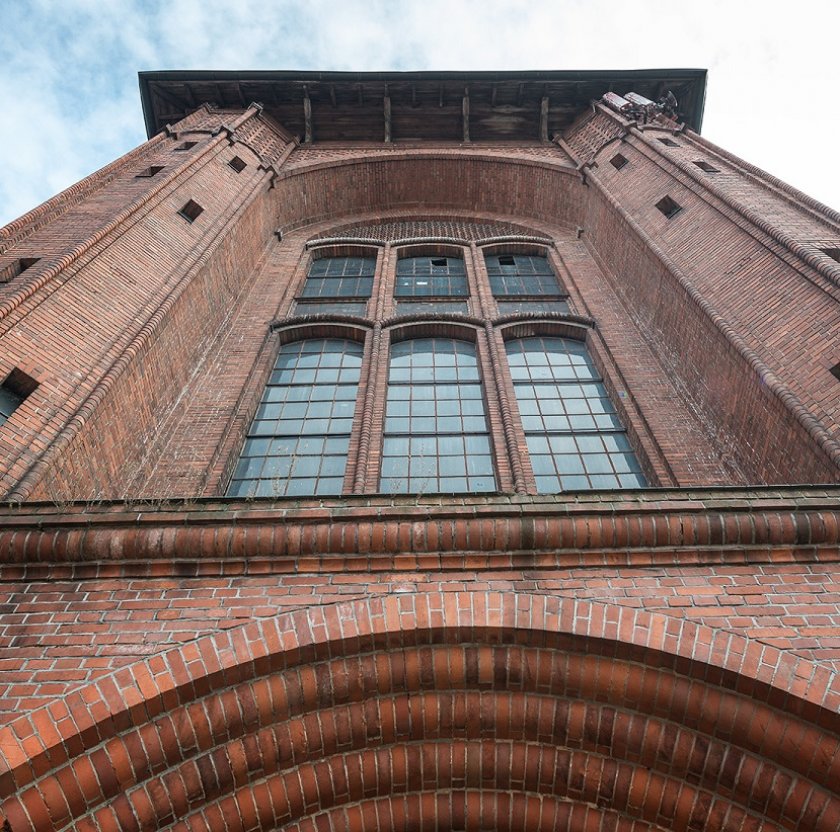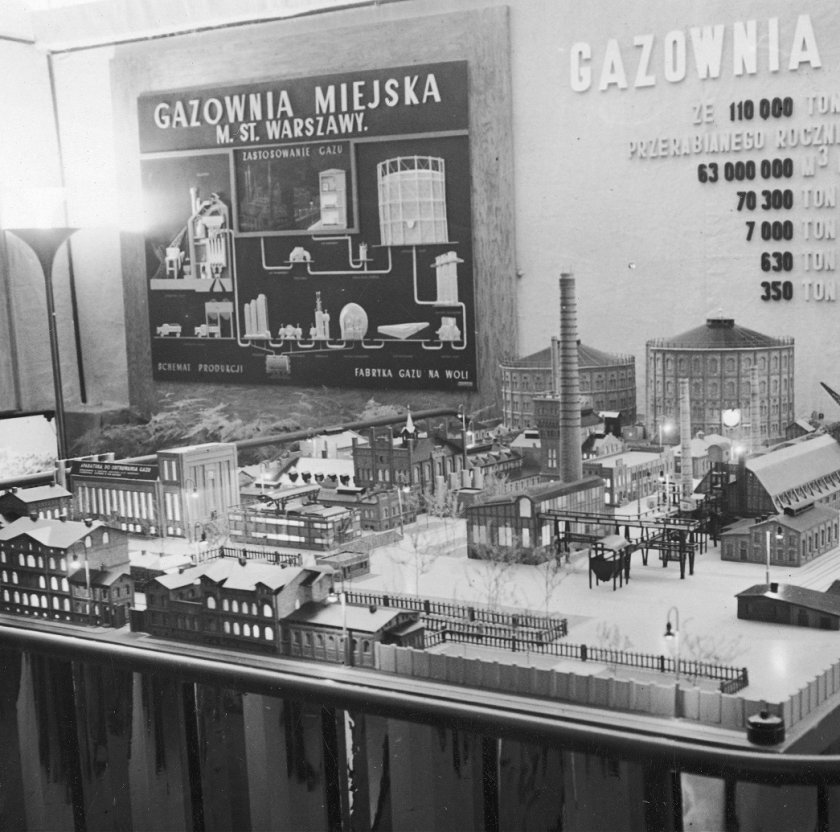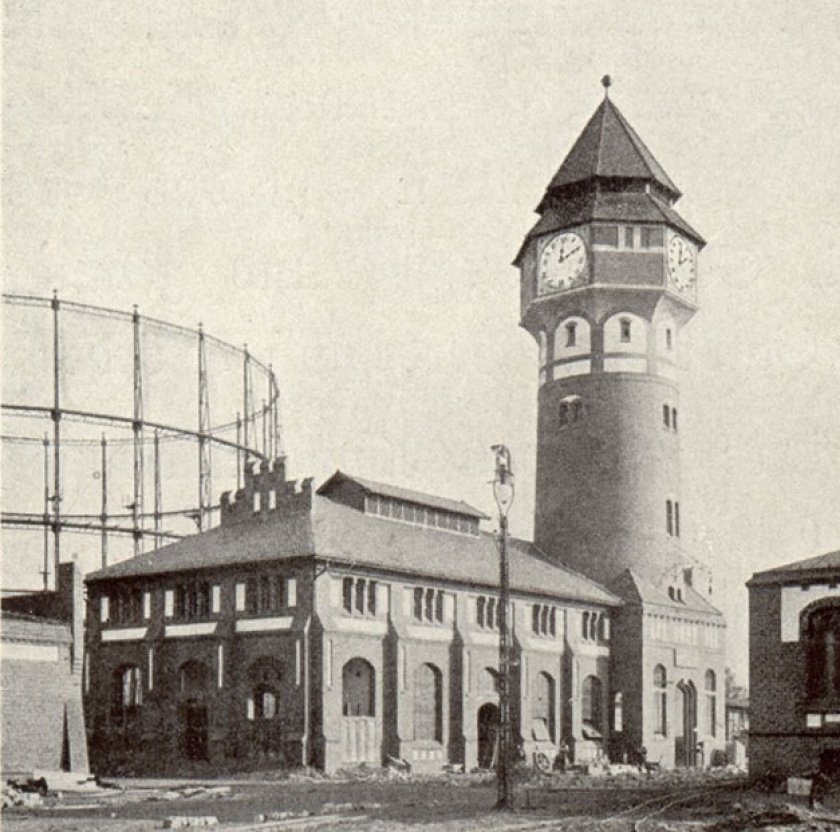History of the Bydgoszcz Gasworks
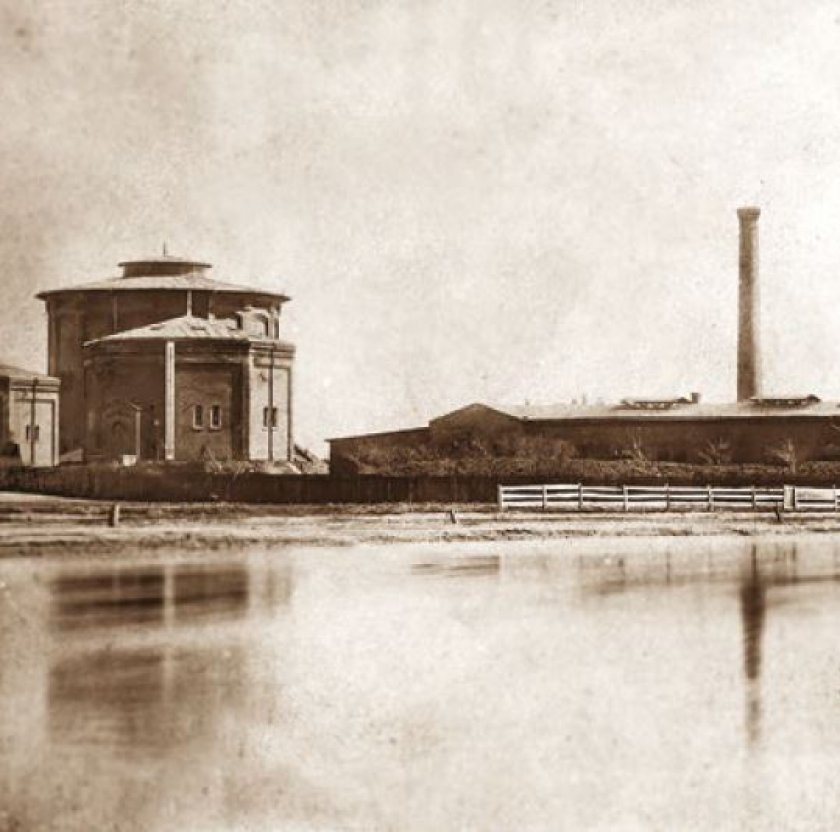 Fot. View of the Bydgoszcz Gasworks from the River Brda
Fot. View of the Bydgoszcz Gasworks from the River Brda
In 1859, Mayor von Foller, who supported this idea, issued bonds of a total value of 100,000 thalers, and after consulting specialists from the Szczecin Gasworks (its director, Wilhelm Kornhardt, was the constructor of the Bydgoszcz Gasworks), he purchased nearly 8 thousand sqm of land located on the River Brda. One furnace with nine retorts, two furnaces with seven retorts and one furnace with four horizontal retorts were installed.
The location on the navigable river was an advantage, as it ensured the supply of special gaseous coal that came to Bydgoszcz from Silesia and England (almost two-thirds of the deliveries) by water over the River Vistula and the Bydgoszcz Canal. Only at the end of the 19th century coal supplies by sea were discontinued, and the plant relied solely on the “black gold” from Silesia.
In the first experimental production stage, manufactured gas was mainly used to light the city. The power of gas exceeded that of candlelight. A natural resistance against novelties and the high cost of the system were the only reasons why the number of customers for gas in Bydgoszcz increased slowly. However, when that resistance was eliminated, the network started to develop fast. Bydgoszcz citizens quickly became used to the presence of a new industrial plant with its characteristic, cylinder-shaped tall tank in the city landscape, with the view opened towards the river. The height of the tank dome varied, depending on the quantity of gas produced, moving up and down, and this was noticed by passers-by.
In the first experimental production stage, manufactured gas was mainly used to light the city. The power of gas exceeded that of candlelight. A natural resistance against novelties and the high cost of the system were the only reasons why the number of customers for gas in Bydgoszcz increased slowly. However, when that resistance was eliminated, the network started to develop fast. Bydgoszcz citizens quickly became used to the presence of a new industrial plant with its characteristic, cylinder-shaped tall tank in the city landscape, with the view opened towards the river. The height of the tank dome varied, depending on the quantity of gas produced, moving up and down, and this was noticed by passers-by.
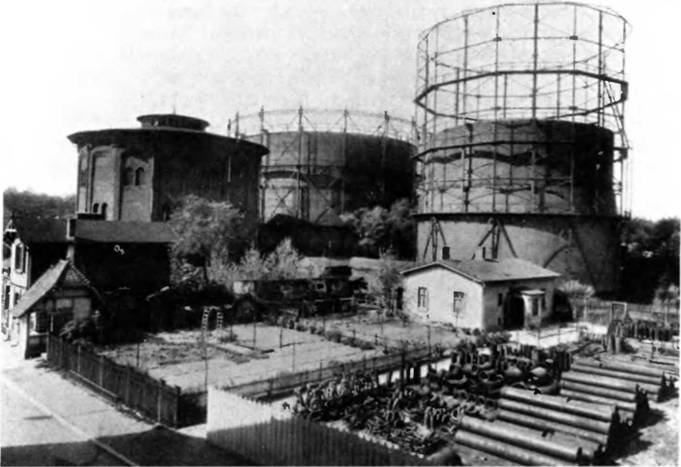
Gas tanks in the Bydgoszcz Gasworks, Schmidt Erich Industrie
und Gewerbe in Bromberg. Bydgoszcz 1907, public domain
In the first months of the Gasworks operations, 285 lanterns were installed in Bydgoszcz streets, replacing former weaker oil lamps hanging on chains routed across streets, which required complex operation and were expensive. The light of new lanterns was much stronger. So strong, in fact, that when they were installed on pavements, the street was well-lit to the middle of its width. Of course, this was the situation only in the very centre of the city, while its suburbs were still shrouded in darkness. When people saw how efficient new lamps were, it was just a question of time and finding financial resources to provide this lighting in the entire city. For this purpose, the plant had to be expanded, and this took place in 1881–1895. Consequently, in 1897, Bydgoszcz suburbs, including Okole, Wilczak and Szwederowo, were connected to the gas lighting network. This became an important event in the lives of the inhabitants of these suburbs. In those days, Bydgoszcz citizens were proud of having their own Gasworks, as using gas for lighting and heating purposes was considered a measure of civilisation development.
The demand for gas in the city increased fast because after Bunsen first invented a burner and then a gas oven in the 1880s’, housewives also started using this material for cooking meals, heating residential rooms by burning it in fireplaces and water in boilers and operating other household appliances, like irons, curlers, dryers, or baking pans. Thus, it was necessary to install new devices and increase coal supplies.
The water transport ceased to be enough, so in 1890, a railway siding was constructed from the Bydgoszcz Main Station through the outskirts of the contemporary city to the Gasworks, used to transport increasing quantities of black coal. The turn of the 19th century was a period of continuous modernisation and expansion of the enterprise.
The water transport ceased to be enough, so in 1890, a railway siding was constructed from the Bydgoszcz Main Station through the outskirts of the contemporary city to the Gasworks, used to transport increasing quantities of black coal. The turn of the 19th century was a period of continuous modernisation and expansion of the enterprise.
In 1907, there were nearly 1500 gas lanterns in Bydgoszcz, operated by supervisors who lit and turned them off at specific times. In total, 40 people had to be employed to operate the lighting network. Three years later, their number was significantly reduced as a new invention was introduced - a remotely controlled device for lighting lanterns, the so-called Rostin’s system.
As it was reported then, the profitability of the Bydgoszcz Gasworks were high, and it got revenues not only from sale of gas, but also of coke and tar, and from lease of gas meters and other gas appliances. In those days, a new solution comprised electrical overhead carts used to transport coal from barges and the railway ramps to the furnace.
As it was reported then, the profitability of the Bydgoszcz Gasworks were high, and it got revenues not only from sale of gas, but also of coke and tar, and from lease of gas meters and other gas appliances. In those days, a new solution comprised electrical overhead carts used to transport coal from barges and the railway ramps to the furnace.
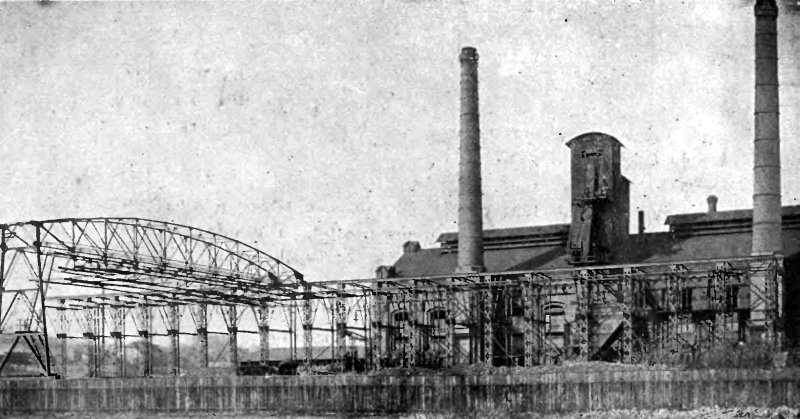
Overhead carts at the Bydgoszcz Gasworks site, Schmidt Erich Industrie
und Gewerbe in Bromberg. Bydgoszcz 1907, public domain
The robust development of the gas network (during the first fifty years of its operation, it was expanded four times, and its length increased to 70 kilometres) was inhibited during WWI, not so much due to war activities, which passed Bydgoszcz by, but due to problems with raw materials and labour shortages.
A change in the state affiliation of Kujawsko-Pomorskie, which became a part of the reinstituted Polish Republic, greatly influenced the further operation of the Gasworks. Bydgoszcz was cut off from deliveries of German coal, and the river transport on Brda collapsed rapidly. This resulted in chaos and stagnation in gas production and sales, and they were accompanied by economic problems common in the first year of the Second Polish Republic’s existence.
A change in the state affiliation of Kujawsko-Pomorskie, which became a part of the reinstituted Polish Republic, greatly influenced the further operation of the Gasworks. Bydgoszcz was cut off from deliveries of German coal, and the river transport on Brda collapsed rapidly. This resulted in chaos and stagnation in gas production and sales, and they were accompanied by economic problems common in the first year of the Second Polish Republic’s existence.
The situation of the Bydgoszcz Gasworks, managed by Poles from 21 January 1920, changed only five years later when engineer Bronisław Klimczak was appointed its director. He started regular education of staff, organised courses and training sessions, and supervised gasworks modernisation. This resulted in a significant increase in gas production and the launching of the production of benzole, a vehicle fuel component, and ammonium sulphate production.
The Gasworks also started manufacturing carbolic oil and processed tar, sold to factories producing electric cables. Under the auspices of the Gasworks Branch of the Association of Polish Gasworks and Waterworks, the first and only in Poland gasworks course was launched in the State Industrial School in Bydgoszcz at Świętej Trójcy Street to educate future personnel.
The Gasworks also started manufacturing carbolic oil and processed tar, sold to factories producing electric cables. Under the auspices of the Gasworks Branch of the Association of Polish Gasworks and Waterworks, the first and only in Poland gasworks course was launched in the State Industrial School in Bydgoszcz at Świętej Trójcy Street to educate future personnel.
The economic situation started to improve in 1936–1939, and then new investments took place. New gas lines were being constructed in the Bydgoszcz suburbs, and old pipes were being replaced. Just before the outbreak of WWII, the city streets were lit by over 1800 lanterns.
The Gasworks profitability was improving, and it started to provide the city with significant profits. The financial status of Bydgoszcz citizens also improved, and an increasing number of them had gas installed in their houses both for lighting and for cooking purposes. For this reason, a room was prepared in the Gasworks administration building where public lectures and presentations on economical cooking on gas were held, and employees from the Gasworks installation department provided services such as installation of ovens, bathroom water heaters, heating furnaces, or equipment repairs and maintenance.
The Gasworks profitability was improving, and it started to provide the city with significant profits. The financial status of Bydgoszcz citizens also improved, and an increasing number of them had gas installed in their houses both for lighting and for cooking purposes. For this reason, a room was prepared in the Gasworks administration building where public lectures and presentations on economical cooking on gas were held, and employees from the Gasworks installation department provided services such as installation of ovens, bathroom water heaters, heating furnaces, or equipment repairs and maintenance.
The period of German occupation brought serious damages to the Gasworks, as its devices were worn out, while no necessary investments were made. War activities in January 1945 caused significant damage. Gasmen needed exactly a month to repair the main devices and restart the plant. From 8 February 1945, those works were managed by Jan Wyżnikiewicz, a newly appointed director of the Municipal Gasworks and an experienced chemical engineer, who was employed at the plant in managerial positions in the interwar period. Under his supervision, gas tanks and furnaces were repaired.
For financial reasons, the thorough rebuilding of the Gasworks and its modernisation could only start in 1948. Three years later, the boiler building and the railway siding were expanded, and a self-propelled crane was also added for coal loading and unloading.
For financial reasons, the thorough rebuilding of the Gasworks and its modernisation could only start in 1948. Three years later, the boiler building and the railway siding were expanded, and a self-propelled crane was also added for coal loading and unloading.
At that time, the demand for gas began to increase rapidly, as Bydgoszcz was becoming a strictly industrial city, started to expand intensely, and the number of its inhabitants was rising. In 1955, households became the main customers of gas in the city. Expanding plants were urgently seeking employees, lands for the construction of large residential districts were being prepared, and the doubling in the number of Bydgoszcz citizens over the decade was planned. It became clear that gasmen were facing serious challenges.
It was obvious that sooner or later, the gasworks location, practically in the centre of the city, would hinder its further expansion. Furthermore, inconveniences associated with the gasworks influence on its nearest surroundings and problems of coal transport by railway had to be considered. Previously running along the city border, the railway line now crossed its main traffic routes.
It was obvious that sooner or later, the gasworks location, practically in the centre of the city, would hinder its further expansion. Furthermore, inconveniences associated with the gasworks influence on its nearest surroundings and problems of coal transport by railway had to be considered. Previously running along the city border, the railway line now crossed its main traffic routes.
The first idea for increasing the Bydgoszcz Gasworks production capacity was to expand the Toruń Gasworks to a significant size and supply gas to Bydgoszcz through a high-pressure gas line from there. However, there were neither resources nor acceptance of decision-makers for that investment. In 1957, a decision was made about another solution - the construction of a new gas manufacturer in Bydgoszcz as a district Gasworks supplying gas within the entire region of the then Bydgoskie Voivodeship. However, this project also was not implemented, pushed out from the plan by a concept to supply the city and the region with gas from a central gas plant in Konin, which was then on designers’ desks.
Eventually, the fourth concept won. In 1959, the decision was made to construct a new gasworks in Bydgoszcz to supply gas solely for the city.
Eventually, the fourth concept won. In 1959, the decision was made to construct a new gasworks in Bydgoszcz to supply gas solely for the city.
Planners located that facility again on Brda, but now much further east from the first one, in the industrial district located along Fordońska Street, in the region of Witebska and Przemysłowa Streets, close to the Bydgoszcz Wschód railway station, which was the most important condition for this location.
The new Bydgoszcz Gasworks was constructed in 1961–1967. Its production capacity was 120 thousand cubic meters of coal gas a day. The plant was based on new technology and modern, partly automated production devices, i.e., vertical-chamber furnaces and generators with a mechanical rotary grate, ensuring the highest production quality and optimum working conditions. The new Gasworks also manufactured coke, tar, phenols and ammonia. The furnace hall contained two blocks of three furnaces with vertical chambers each, with 5.1 tonnes batch per chamber and a degassing time of 18 hours.
The new Bydgoszcz Gasworks was constructed in 1961–1967. Its production capacity was 120 thousand cubic meters of coal gas a day. The plant was based on new technology and modern, partly automated production devices, i.e., vertical-chamber furnaces and generators with a mechanical rotary grate, ensuring the highest production quality and optimum working conditions. The new Gasworks also manufactured coke, tar, phenols and ammonia. The furnace hall contained two blocks of three furnaces with vertical chambers each, with 5.1 tonnes batch per chamber and a degassing time of 18 hours.
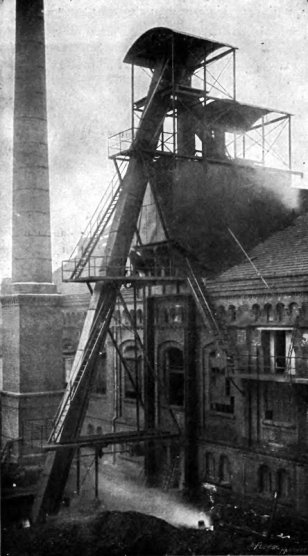
Mechanical transport of coal to a furnace
at the Bydgoszcz Gasworks, Schmidt Erich
Industrie und Gewerbe in Bromberg.
Bydgoszcz 1907, public domain
Products were transported solely on conveyors through angle and dump stations. Simultaneously with technological and production facilities, a modern wastewater treatment plant was constructed, the first mechanical and biological one in the entire region.
Meanwhile, the last gas lanterns in the city were successively removed. These elements of the city landscape were irreversibly becoming a thing of the past. On 30 September 1967, gas from the new gasworks was supplied to Bydgoszcz plants and flats. At that time, the gas network in Bydgoszcz was almost 150 km long. In the 1960s, to ensure the even distribution of pressure, medium-pressure gas lines were constructed in individual city districts, as well as a gas compression station at the site of the old Gasworks
Meanwhile, the last gas lanterns in the city were successively removed. These elements of the city landscape were irreversibly becoming a thing of the past. On 30 September 1967, gas from the new gasworks was supplied to Bydgoszcz plants and flats. At that time, the gas network in Bydgoszcz was almost 150 km long. In the 1960s, to ensure the even distribution of pressure, medium-pressure gas lines were constructed in individual city districts, as well as a gas compression station at the site of the old Gasworks
With the construction of the new facility, a high-pressure gas line to Grudziądz was also laid, so when the new plant was started, the municipal gas was delivered to Grudziądz to cover the deficit in its municipal network. However, this concept was used as planned only for a short time because several years after the pipeline completion, it was used to send gas, but... natural one, and in the opposite direction, from Grudziądz to Bydgoszcz.
The beginning of the 1970s, brought very important changes in gas supplies for Bydgoszcz. In 1973, the old, 19th-century Gasworks was completely shut down, and the entire network started to be adapted to a transfer from municipal (coal) gas to natural gas. From that moment on, at the Gasworks at Jagiellońska Street, only tanks filled at night with gas delivered from the new Gasworks were operating.
The beginning of the 1970s, brought very important changes in gas supplies for Bydgoszcz. In 1973, the old, 19th-century Gasworks was completely shut down, and the entire network started to be adapted to a transfer from municipal (coal) gas to natural gas. From that moment on, at the Gasworks at Jagiellońska Street, only tanks filled at night with gas delivered from the new Gasworks were operating.
Already during the start-up of the new Gasworks at Witebska Street, whiffs of a real gas revolution, which was to come in the foreseeable future, were reaching Bydgoszcz. Poland was to be covered by a network, leading from the south to the north, for transmission of natural gas, which was to replace the previously used lighting gas completely.
In the 1970s’, Bydgoszcz was gradually encircled by medium-pressure gas lines and pressure-reducing stations. When the construction of the Otorowo-Solec Kujawski gas line began, adapted to the technical conditions for high-pressure gas lines, Bydgoszcz received a supply of natural gas from two sides, enabling the inhabitants of the Leśne district to receive it as first. This happened precisely on 7 March 1973.
In the 1970s’, Bydgoszcz was gradually encircled by medium-pressure gas lines and pressure-reducing stations. When the construction of the Otorowo-Solec Kujawski gas line began, adapted to the technical conditions for high-pressure gas lines, Bydgoszcz received a supply of natural gas from two sides, enabling the inhabitants of the Leśne district to receive it as first. This happened precisely on 7 March 1973.
Five years later, when that gas line was connected with the new high-pressure gas line from Gniewkowo to the village Rudy near Bydgoszcz and the constantly monitored pressure-reducing and metering station in Otorowo, a new chapter in the history of gas in service of inhabitants of Bydgoszcz and its region began for good.
In the 1980s, municipal gas in the Bydgoszcz network was successively replaced with natural gas. This process finally led to the closing of the Gasworks at Witebska Street in 1990.
In the 1980s, municipal gas in the Bydgoszcz network was successively replaced with natural gas. This process finally led to the closing of the Gasworks at Witebska Street in 1990.
